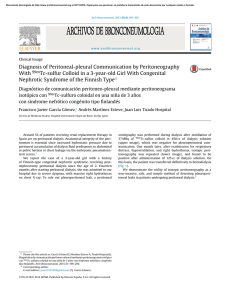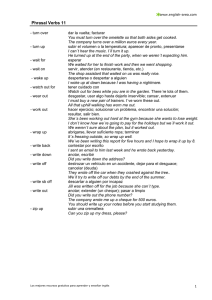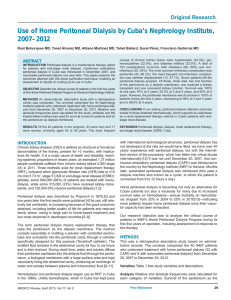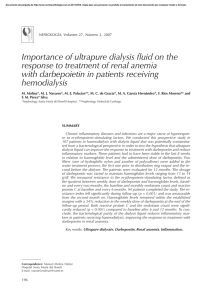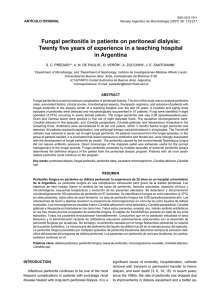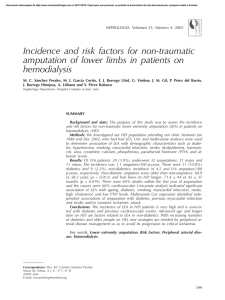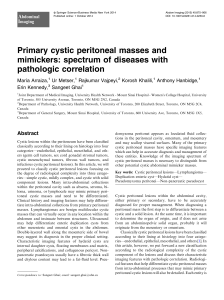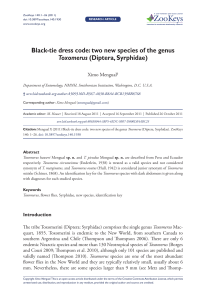Dialysis - Spanish - Health Information Translations
Anuncio
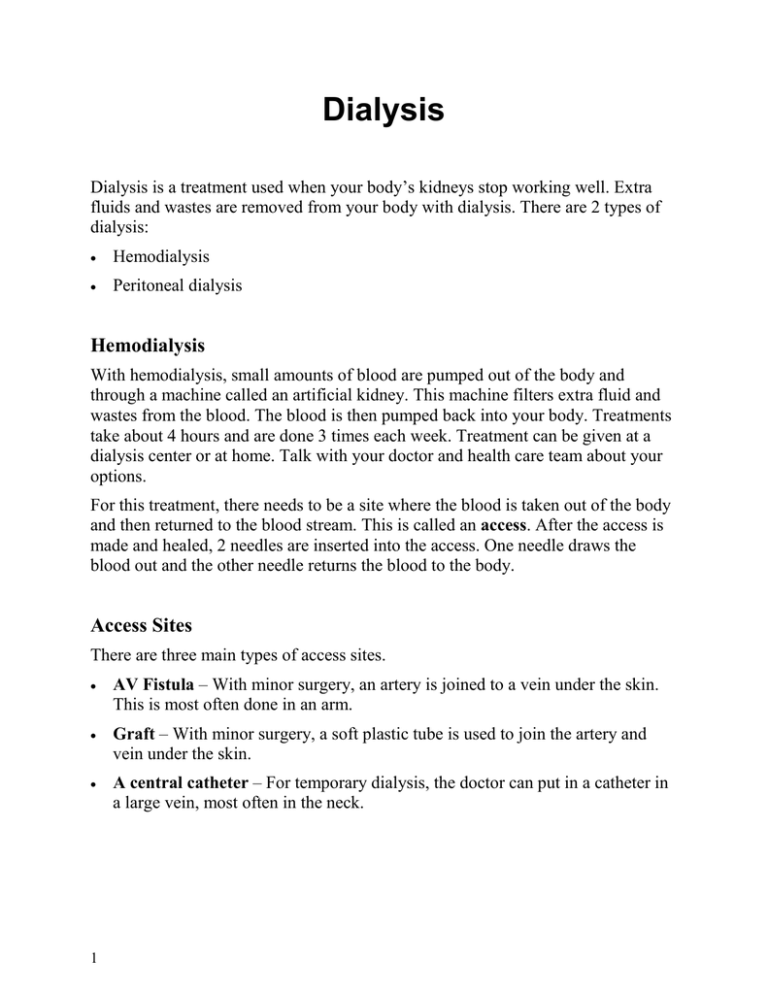
Dialysis Dialysis is a treatment used when your body’s kidneys stop working well. Extra fluids and wastes are removed from your body with dialysis. There are 2 types of dialysis: • Hemodialysis • Peritoneal dialysis Hemodialysis With hemodialysis, small amounts of blood are pumped out of the body and through a machine called an artificial kidney. This machine filters extra fluid and wastes from the blood. The blood is then pumped back into your body. Treatments take about 4 hours and are done 3 times each week. Treatment can be given at a dialysis center or at home. Talk with your doctor and health care team about your options. For this treatment, there needs to be a site where the blood is taken out of the body and then returned to the blood stream. This is called an access. After the access is made and healed, 2 needles are inserted into the access. One needle draws the blood out and the other needle returns the blood to the body. Access Sites There are three main types of access sites. • AV Fistula – With minor surgery, an artery is joined to a vein under the skin. This is most often done in an arm. • Graft – With minor surgery, a soft plastic tube is used to join the artery and vein under the skin. • A central catheter – For temporary dialysis, the doctor can put in a catheter in a large vein, most often in the neck. 1 Diálisis La diálisis es un tratamiento que se usa cuando los riñones dejan de funcionar adecuadamente. Por medio de este tratamiento, se elimina el exceso de líquidos y desechos del cuerpo. Existen 2 tipos de diálisis: • Hemodiálisis • Diálisis peritoneal Hemodiálisis En la hemodiálisis, se bombean pequeñas cantidades de sangre fuera del cuerpo y se hacen pasar a través de una máquina llamada riñón artificial. Esta máquina filtra el exceso de líquidos y desechos de la sangre. Luego la sangre se bombea de regreso al cuerpo. Los tratamientos duran alrededor de 4 horas y se realizan 3 veces a la semana. El tratamiento se puede administrar en un centro de diálisis o en su hogar. Hable con su médico y con su equipo de atención médica acerca de sus opciones. Para este tratamiento, tiene que haber un sitio por donde la sangre se extraiga del cuerpo y luego se devuelva al torrente sanguíneo. Esto se llama un acceso. Después de que se haya realizado y cicatrizado el acceso, se insertan 2 agujas en él. Una aguja extrae la sangre y la otra la devuelve al cuerpo. Lugares de acceso Existen tres tipos principales de lugares de acceso. • Fístula arteriovenosa: por medio de una cirugía menor, se une una arteria a una vena bajo la piel. Se realiza con mayor frecuencia en un brazo. • Injerto: por medio de una cirugía menor, se usa un tubo plástico suave para unir la arteria y la vena bajo la piel. • Un catéter central: para diálisis temporal, el médico puede introducir un catéter en una vena grande, con mayor frecuencia en el cuello. Dialysis. Spanish. 1 Peritoneal Dialysis With peritoneal dialysis, a catheter is put into the abdomen. Special fluid, called dialysate, is put into the abdomen through the catheter. The fluid stays in the abdomen for several hours. During this time, the body’s extra fluid and wastes move from the blood to the fluid. This fluid is much like urine, and it is then drained from the body through the catheter. Clean fluid is then put into the abdomen, and the steps are repeated. There are 2 main types: • Continuous Ambulatory Peritoneal Dialysis (CAPD) is done 4 to 5 times each day and the fluid stays in the abdomen for 3 to 4 hours. This can be done anywhere there is a clean, private area. • Continuous Cycling Peritoneal Dialysis (CCPD) is done using a special machine. The fluid stays in the abdomen for a shorter time, about 1½ hours. The machine is set up and the person is connected to this machine for 8 to 10 hours during the night. The person is unhooked from the machine during the day. Talk to the staff if you have any questions or concerns. 2008 – 1/2012 Health Information Translations Unless otherwise stated, user may print or download information from www.healthinfotranslations.org for personal, non-commercial use only. The medical information found on this website should not be used in place of a consultation with your doctor or other health care provider. You should always seek the advice of your doctor or other qualified health care provider before you start or stop any treatment or with any questions you may have about a medical condition. Wexner Medical Center at The Ohio State University, Mount Carmel Health System, OhioHealth and Nationwide Children’s Hospital are not responsible for injuries or damages you may incur as a result of your stopping medical treatment or your failure to obtain medical treatment. 2 Diálisis peritoneal En una diálisis peritoneal, se introduce un catéter en el abdomen. A través del catéter, se introduce en el abdomen un líquido especial llamado dializado. El líquido permanece ahí por varias horas. Durante este período, el exceso de líquido y desperdicios del cuerpo pasa de la sangre al líquido. Este líquido es parecido a la orina y luego se drena del cuerpo a través del catéter. Se introduce líquido limpio en el abdomen y se repiten los pasos. Existen 2 tipos principales: • La diálisis peritoneal ambulatoria continua (CAPD, por sus siglas en inglés) se realiza de 4 a 5 veces todos los días y el líquido permanece en el abdomen por 3 a 4 horas. Esto se puede realizar en cualquier lugar donde haya un área limpia y privada. • La diálisis peritoneal cíclica continua (CCPD, por sus siglas en inglés) se realiza usando una máquina especial. El líquido permanece en el abdomen por un período más breve, alrededor de 1½ horas. Se configura la máquina y se le conecta a la persona durante 8 a 10 horas en la noche. Durante el día, la persona está desconectada de la máquina. Hable con el personal si tiene alguna pregunta o duda. 2008 – 1/2012 Health Information Translations Unless otherwise stated, user may print or download information from www.healthinfotranslations.org for personal, non-commercial use only. The medical information found on this website should not be used in place of a consultation with your doctor or other health care provider. You should always seek the advice of your doctor or other qualified health care provider before you start or stop any treatment or with any questions you may have about a medical condition. Wexner Medical Center at The Ohio State University, Mount Carmel Health System, OhioHealth and Nationwide Children’s Hospital are not responsible for injuries or damages you may incur as a result of your stopping medical treatment or your failure to obtain medical treatment. Dialysis. Spanish. 2

